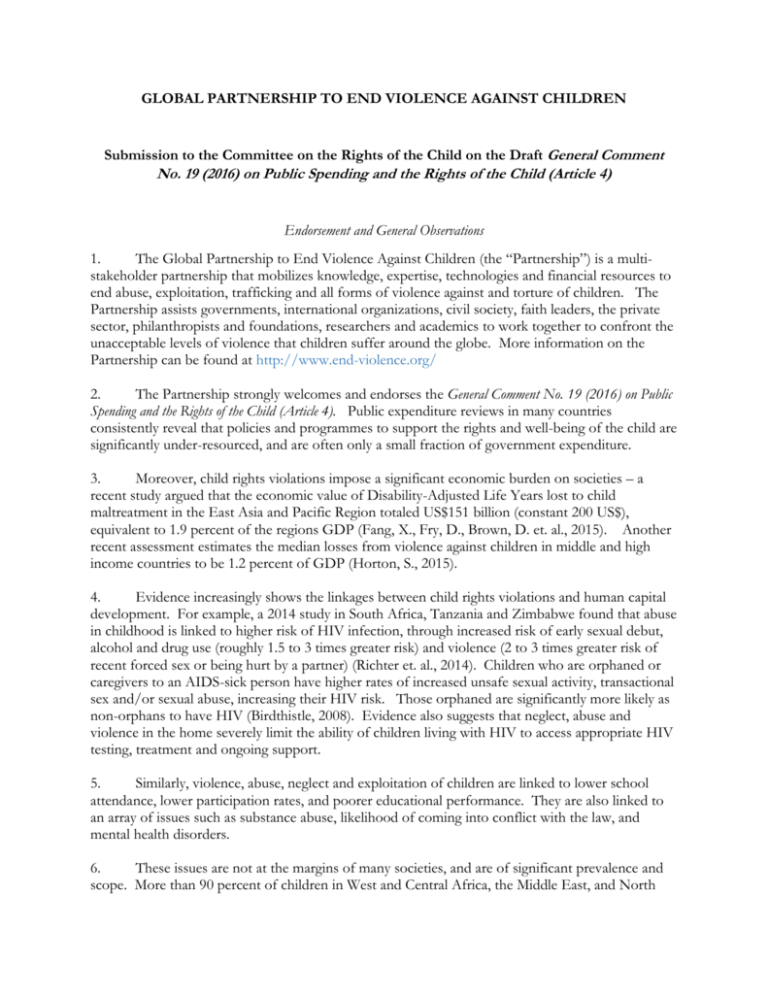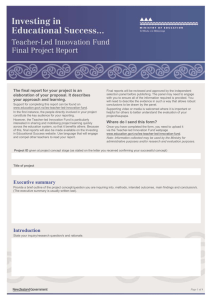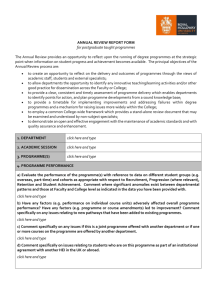GLOBAL PARTNERSHIP TO END VIOLENCE AGAINST CHILDREN
advertisement

GLOBAL PARTNERSHIP TO END VIOLENCE AGAINST CHILDREN Submission to the Committee on the Rights of the Child on the Draft General Comment No. 19 (2016) on Public Spending and the Rights of the Child (Article 4) Endorsement and General Observations 1. The Global Partnership to End Violence Against Children (the “Partnership”) is a multistakeholder partnership that mobilizes knowledge, expertise, technologies and financial resources to end abuse, exploitation, trafficking and all forms of violence against and torture of children. The Partnership assists governments, international organizations, civil society, faith leaders, the private sector, philanthropists and foundations, researchers and academics to work together to confront the unacceptable levels of violence that children suffer around the globe. More information on the Partnership can be found at http://www.end-violence.org/ 2. The Partnership strongly welcomes and endorses the General Comment No. 19 (2016) on Public Spending and the Rights of the Child (Article 4). Public expenditure reviews in many countries consistently reveal that policies and programmes to support the rights and well-being of the child are significantly under-resourced, and are often only a small fraction of government expenditure. 3. Moreover, child rights violations impose a significant economic burden on societies – a recent study argued that the economic value of Disability-Adjusted Life Years lost to child maltreatment in the East Asia and Pacific Region totaled US$151 billion (constant 200 US$), equivalent to 1.9 percent of the regions GDP (Fang, X., Fry, D., Brown, D. et. al., 2015). Another recent assessment estimates the median losses from violence against children in middle and high income countries to be 1.2 percent of GDP (Horton, S., 2015). 4. Evidence increasingly shows the linkages between child rights violations and human capital development. For example, a 2014 study in South Africa, Tanzania and Zimbabwe found that abuse in childhood is linked to higher risk of HIV infection, through increased risk of early sexual debut, alcohol and drug use (roughly 1.5 to 3 times greater risk) and violence (2 to 3 times greater risk of recent forced sex or being hurt by a partner) (Richter et. al., 2014). Children who are orphaned or caregivers to an AIDS-sick person have higher rates of increased unsafe sexual activity, transactional sex and/or sexual abuse, increasing their HIV risk. Those orphaned are significantly more likely as non-orphans to have HIV (Birdthistle, 2008). Evidence also suggests that neglect, abuse and violence in the home severely limit the ability of children living with HIV to access appropriate HIV testing, treatment and ongoing support. 5. Similarly, violence, abuse, neglect and exploitation of children are linked to lower school attendance, lower participation rates, and poorer educational performance. They are also linked to an array of issues such as substance abuse, likelihood of coming into conflict with the law, and mental health disorders. 6. These issues are not at the margins of many societies, and are of significant prevalence and scope. More than 90 percent of children in West and Central Africa, the Middle East, and North Africa are subject to physical or psychological discipline (as are roughly three-quarters of children in east Asia and the Pacific, Latin America and the Caribbean) (Horton, S., 2015). A 2004 World Health Organisation review of research estimated the global prevalence of childhood sexual victimization to be about 27 percent among girls and around 14 percent among boys. This is a global epidemic with profound effects on the futures of States. 7. Accordingly, the General Comment’s call for adequate, efficient and effective expenditure to support the rights of the child is supportive of long term poverty reduction and economic growth. This will enhance the well-being and quality of life of children, their families and communities, and help to break inter-generational cycles of poverty. Macroeconomic and sectoral policies and programmes should incorporate the approaches outlined in the General Comment, including related measures to strengthen public expenditure management systems and how they reflect the allocation of resources for child rights. 8. The Partnership applauds a consultative process on the General Comment that included the voices of 2,693 children from 71 different countries, along with a comprehensive dialogue with an array of global and national stakeholders. Recommendations 8. The Partnership recommends that the General Comment’s provisions on ensuring sufficient, effective, efficient and equitable public expenditure to support the Convention and Optional Protocols (Article I and following) be maintained in the next iteration of the document to ensure the desired outcomes on child rights and well-being, poverty reduction and economic growth, and reductions of violence against children. 9. The Partnership would welcome a more explicit statement on the importance of child protection as a key component of policies, programmes and budgeting for child rights, specifically referring to preventing and responding to violence, exploitation, abuse and neglect of children in accordance with the definition and approaches outlined in UNICEF’s Child Protection Strategy (2008). Related, the Partnership endorses public expenditure management approaches that support holistic approaches to the child, recognizing that a child’s development is affected by the number, duration, type, and severity of her or his exposure to a wide range of risks and adversities. Broadly speaking, the Partnership favors case management approaches that are aligned with the General Comment’s endorsement of the best interests of boys and girls (Article 2), along with the development of a strong social service workforce to support the achievement of children’s rights and well-being. 10. There is a particular challenge to establishing public expenditure systems for child rights, in that the related policies and programmes are multi-sectoral (involving social welfare, health, education, justice, interior, and other sectors). There are no known cases of national ministries that are exclusively engaged in ‘child rights,’ and this can make it difficult to develop a well-articulated coordinated policy and budget program with clearly identified advocates. The General Comment might highlight the need to ensure the development of a clear, articulated national vision for child rights, and appropriate cross-sectoral coordination mechanisms that feed into the policy and public expenditure management process. 11. Article I might broaden the definition of laws and programmes to embody quality and access of ‘services,’ which are a primary mechanism through which programmes will be realized. 12. The Rationale section (Article I), particularly paragraph 14, might be greatly strengthened by including information on the linkages with growth and poverty reduction, for example the type of information presented in the first paragraphs of this Submission to the Committee. Such data will also strengthen the case as to why child rights should be viewed as a priority by States Parties. 13. The Partnership welcomes the pragmatism of the General Comment’s approach to “progressive realization” of the full implementation of child rights, noting the challenge of the lack of organizational, human and financial resources in many States. One measure to facilitate such realization is to ensure that child right’s is effectively reflected in longer term expenditure frameworks (of three to five years or more), where a progressive increase in resources allocated to child rights can be reflected against national policies, programmes and services in this area. 14. With regards to Article 5, the Partnership believes the case for promoting an international cooperative framework for child rights will be strengthened if the linkages to growth and poverty reduction are better articulated, as noted above. Approaches that strengthen national and local capacity and sustainability are favored, and the Partnership welcomes the General Comment’s observations on the need to ensure that development cooperation does not negatively impact the rights of the child. Conclusion 15. The Partnership commends the Committee on the preparation of this draft, and looks forward to its enactment and implementation. We stand ready to respond to any questions or comments on this Submission, and would be pleased to provide any additional information to the Committee at its request.






